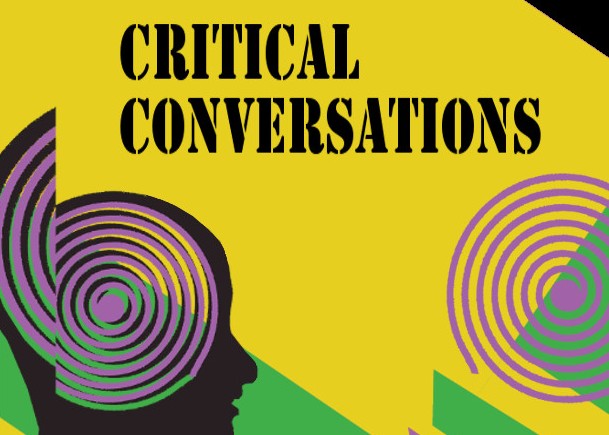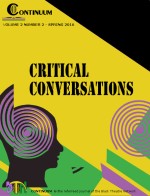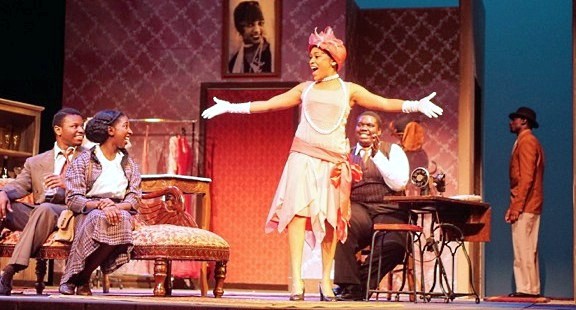
Continuum:
TABLE OF CONTENTS
Technical Notes/Browsing the Journal
Editorial Notes: "Critical Conversations" - Freda Scott Giles
ARTICLES
![]() Valorizing Ancestor Discourse: Harlem Renaissance Criticism and Theatre Theory
Valorizing Ancestor Discourse: Harlem Renaissance Criticism and Theatre Theory
Henry Miller
{-- ::Today our history seems to vanish into the mainstream twenty-four hour news cycle, and we tend not to valorize our ancestors, immediate or distant. If we do valorize them, it is in name only. Too many of us seem to have forgotten just why it is we are standing on so many bye-gone shoulders.
This writing includes the vital discourse on the nature of Black drama as carried on by our immediate ancestors in the period known as the Harlem Renaissance; it includes consideration of the writings of W.E.B. DuBois, Alain Locke, James Weldon Johnson, Angelina Grimké, and Hubert Harrison. It argues that the development of black American theatre criticism and theory cannot be properly considered in a purely social and political "vacuum of blackness," divorced from the major events of 20th century history.
The Great Depression, World War II, the Civil Rights Movement, etc., have all, quoting Harold Cruse, helped to establish an "historical discontinuity" that has often separated black Americans from their cultural history, most especially in the area of black theatre criticism and theory. This circumstance has all but destroyed a vital cultural and aesthetic continuum that this discussion, at least in part, seeks to restore.} ABSTRACT {/--} {-- ::Director, Dramatist, Theatre Scholar Henry Miller has taught and lectured at the City University of New York, Kean College in New Jersey, North Carolina A&T State University, The University of Kansas, and in the Arts and Theology Program at the Memphis Seminary. His McFarland book, Theorizing Black Theatre, was published in 2011. He has also written for the African American Review, the New York Village Voice, Theatre Survey, and Columbia Pictures. His plays have been published by the Alexander Street Press and Samuel French, Inc.
Miller has directed for the Indianapolis Opera, the Opera Company of Philadelphia, Opera Ebony in New York, and much of the African American canon of drama in Regional and Off-Off Broadway theatre venues. His film, Death of a Dunbar Girl, was exhibited in Black film festivals in Paris, London, Rome, and New York. Miller founded three South Bronx and Harlem New York theatre companies.} BIO {/--}
Today our history as a nation and as a people seems to vanish into the thin air of the mainstream media's twenty-four hour news cycle, and we tend not to valorize our ancestors, immediate or distant. If we do valorize them, it is mostly in name only. That is, we have forgotten, if we ever knew, why it is that we are, in fact, standing on so many bygone shoulders.
Historical Background
It is difficult to know with reasonable certainty when the ideas about black American theatre criticism and theory that dominated the Harlem Renaissance were first posed; their seeds reach back into the nineteenth century. Most of the men—and women, too—of the Renaissance who posed these ideas in their plays and critical writings were themselves either members or products of what William Easton, an early African-American playwright of the 1890s, called the "emancipation literati." . . .
![]() SHADES OF BLUES: A Season of Resurrected Writers and Reclaimed Music-the Blues
SHADES OF BLUES: A Season of Resurrected Writers and Reclaimed Music-the Blues
Mikell Pinkney
{-- ::Abstract: This essay was originally written at the request of, Kemati Porter, Executive Director of Chicago’s eta Creative Arts Foundation. The major goal of the essay was to assist in explaining the particular theoretical concept of blues aesthetics in relation to the theatre’s 2012-2013 season of revived plays and one emerging artist; (The Amen Corner, Ceremonies in Dark Old Men, Florence & Wine in the Wilderness, Jar the Floor, Hoodoo Love). The essay was placed on the theatre’s online webpage to assist company members, audiences and patrons to understand how the six selected plays related to the overall theme, “Shades of the Blues.” Another important intent was to provide information for Chicago theatre reviewers and critics with a frame and background by which to evaluate plays from the black theatre canon. The essay includes brief background information and definition of African-American dramatic theory and explains blues aesthetics as a legitimate literary critical theory. A hoped for outcome is that readers may also gain an awareness and respectful understanding of cross cultural art and aesthetics.} ABSTRACT {/--} {-- ::Mikell Pinkney is a tenured faculty member at the University of Florida, teaching performance and dramatic theory courses. He is also an accomplished actor and stage director for Broadway, Off and off-off-Broadway, and former Artistic Director for the Billie Holiday Theatre in Brooklyn, NY, and Harmonie Park Playhouse in Detroit, MI. His studies include; BA-Hampton Institute, graduate studies at University of Michigan and NYU, MA and PhD-The Ohio State University. He is a past president and former consultant for Black Theatre Network (BTN).} BIO {/--}
Too often and for far too long there has been a main stream belief that Negro theatre, black theatre and theatre created by and for African Americans has not been founded on clearly defined independently derived aesthetic principles. Theatre about black Americans has been attempted by many, including white writers of note. However, such "other" writers have used Negros/ blacks/ African-American as objects for their own purposes rather than as truly authentic subjects. The prevailing belief had been that most theatre created by African-American artists within the scope of their own perspectives and experiences has been either an imitation of European forms and structures (primarily realism), oddly abstracted and imitative African ritualistic stylings or creations based on not much more than emotional and melodramatic rants or simplistic comedic-musical entertainments. Neither of these assumptions is true, at least certainly not since the successes of award winning black dramatists like Lorraine Hansberry, Charles Gordone, August Wilson, Suzan-Lori Parks and Lynn Nottage.. . . .
![]() From August Wilson to Tyler Perry: Crossing Paths on the Way to Tomorrow
From August Wilson to Tyler Perry: Crossing Paths on the Way to Tomorrow
Gene Bryan Johnson
{-- :: "From August Wilson to Tyler Perry: Crossing Paths on the Way to Tomorrow" begins by asking why events such as the NAACP Image Awards do not recognize black playwriting. I trace the roots of Tyler Perry's financial success to urban Gospel theatre marketing innovations developed in the Frankfurt School-like environment of New York City circa 1984, and demonstrate how black communities bore a significant portion of the pain yet contributed the lion's share of meaningful artistic expression. This essay connects Wilson's roots as a disciple in the tradition of the 1960s Black Power movement to his belief in the need for contemporary theatre "about us, by us, for us and near us," and intertwines historical facts with personal anecdotes and interviews with actor/scholar Stephen McKinley Henderson, members of Wilson's production team and estate, TOBA circuit veteran Bill Dillard, urban Gospel theatre producer Tiffani Gavin, scholars Paul Carter Harrison, Todd Boyd and Carlton Molette and others. I argue that, while Perry's "plays" do not reach the artistic level of Wilson's theatre, Perry's use of the Internet and social media has set a new standard for identifying, identifying with, marketing to, entertaining and inviting black audiences into the theatre..} ABSTRACT {/--} {-- ::Gene Bryan Johnson earned an M.A. from the arts and culture concentration of the Columbia University Graduate School of Journalism in New York City under the direction of Professor Alisa Solomon. He also studied dramatic writing at the Columbia University School of the Arts and New York University where he was a Founder's Day Scholar and earned a B.A. in Humanities with a concentration in creative writing. He was editor of the Harlem Radio and Photography Project, co-producer of The New York Shakespeare Festival's Hamlet for Radio and executive producer of McGraw-Hill Higher Education's Reel Society series of interactive movies. He was writer, producer and managing editor for season 1 of public radio's The Really Big Questions. GBJ is an accomplished composer and is currently writing "Negroes Anonymous: For When Your Parents Made You Hide The Black" a multiplatform play in 12 steps.} BIO {/--}
Nominees for the 38th Annual NAACP Image Awards were announced in early January of 2007. It was a perfect opportunity for an institution billing itself as "the nation's premier event celebrating the outstanding achievements and performances of people of color in the arts" to recognize the late August Wilson, arguably the greatest American playwright of his generation. Wilson, an African-American, had died a little more than a year before, on October 2, 2005 and enough time had passed for the Black American mainstream to give the man his due. From Gem of the Ocean to Radio Golf, the ten plays that comprise his one-play-per-decade dramatization of the 20th Century, as mostly experienced by African American residents of Pittsburgh's Hill District, is a brilliantly conceived portfolio of daunting complexity and stunning simplicity. . .
Book Reviews
![]() solo/black/woman: scripts, interviews, and essays. Edited by E. Patrick Johnson and Ramón H. Rivera-Servera
solo/black/woman: scripts, interviews, and essays. Edited by E. Patrick Johnson and Ramón H. Rivera-Servera
Kristyl Dawn Tift
solo/black/woman is an anthology of seven solo performance pieces devised and performed by black women—Sharon Bridgforth, Edris Cooper-Anifowoshe, Nancy Cheryll Davis-Bellamy, Misty DeBerry, Rhodessa Jones, Robbie McCauley, and Stacey Karen Robinson. In the Foreword, D. Soyini Madison rightly asserts that "[s]olo black women (SBW) complicate the redundancy of performativity and the talk about it through black female stylizations that are not contingent upon natural repetitions, but on the unnaturalized, resistant, Africanist, gestural economies across black female circumAtlantics" (xiii). Pointing to the nuances and diversity of black feminist and woman-centered drama, Madison concludes that "[t]he gift of SBW is that, inside performance, these black female performativities are not necessarily revealed as naturalized repetitions that shape identity, because their alterity is illuminated and their stylized acts are constantly teasing identity" (xiii). solo/black/woman clearly evinces the significance of U.S. black women's lives and the performance of those narratives for the performer and the audience.
![]() The Cambridge Companion to African American Theatre. Edited by Harvey Young
The Cambridge Companion to African American Theatre. Edited by Harvey Young
Shondrika Moss-Bouldin
This is a powerful teaching tool for exploring African American performance and interrogating the social construction of race in America. There are reoccurring issues in many of the chapters which can help students understand the impact of race on African American theatre. Preceding the volume's introduction is a chronological history, beginning with the first enslaved Africans' arrival in America through 2012, when Audra McDonald won a Tony Award for Best Actress in Suzan-Lori Parks' adaptation of Porgy and Bess. This sets the context for the book and the history it encompasses.. . .
Production Reviews
![]() The Brothers Size by Tarell Alvin McCraney
The Brothers Size by Tarell Alvin McCraney
Artisia Green
The Brothers Size by Tarell McCraney was presented by Norfolk State University Theatre as part of the 2015 National Black Theatre Festival College Fringe, one of only two collegiate productions selected to participate. North Carolina Central University's The Bluest Eye by Toni Morrison was the other. Size, the second installment of the The Brother/Sister Plays, is a premeditated remembering of Yoruba mythology and African storytelling purposed to involve the sensibilities of the audience. Bridging the gulf of the stage—an allegorical chthonic realm—actors are both divine and human as they chronicle fate and perform the story. This feature is one of the play's charms.. . .
![]() The Movement by Kathy D. Harrison
The Movement by Kathy D. Harrison
Billicia Hines
Imagine a time where there were no arrests for the eighteen bombings in seven years. Imagine a Civil Rights leader chain-whipped because he attempted to enroll his child in an all white school. Imagine a car of young black men driving from an underground civil rights meeting. They are stopped and almost being beaten to death by the police. Imagine the fear of a black person's life emanating at every turn. Because of the many recent incidents in this nation, it is not hard to imagine. However in 1963, there were no cell phones to record horrific everyday events to send to the press. The idea of a black person as president was only a dream. Martin Luther King, Jr. was serving time in the Birmingham Jail, hitting a low point in the movement. Led by Reverend James Bevel, The Children's March in Birmingham in 1963 rejuvenated the movement to a transformative place in history. Kathy D. Harrison, Founder/Artistic Director of the Diversity Youth Theatre ( DYT), wrote and directed a powerful a cappella musical that encapsulated the children's struggle for equal rights in Birmingham, Alabama. The DYT's performance at the National Black Theatre Festival between August 7-8, 2015 reminded us of this powerful story of triumph... . .
PHOTO GALLERY
Blues for an Alabama Sky by Pearl Cleage. Performed at Charles Winter Wood Theatre, Florida A&M University, Oct. 21 - 25, 2015. Photograph by Evelyn Tyler.




